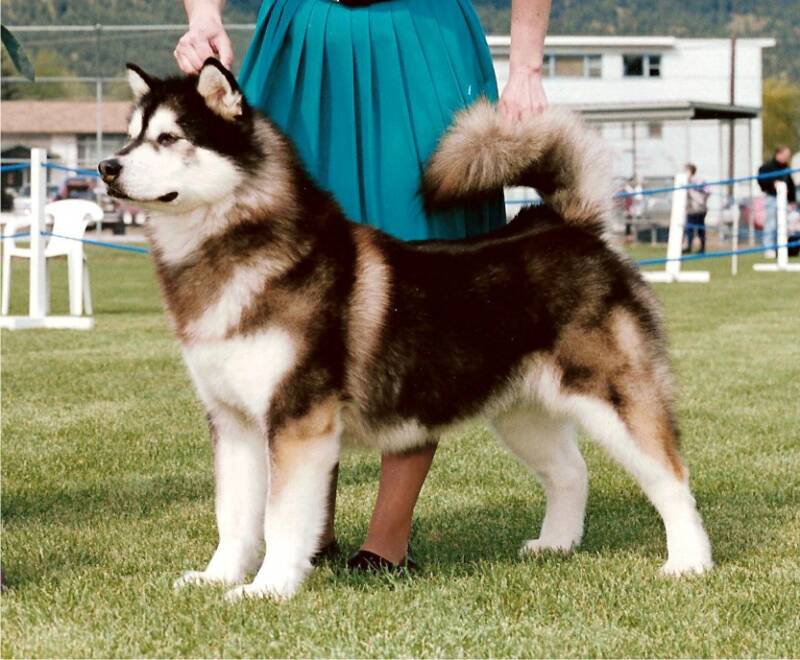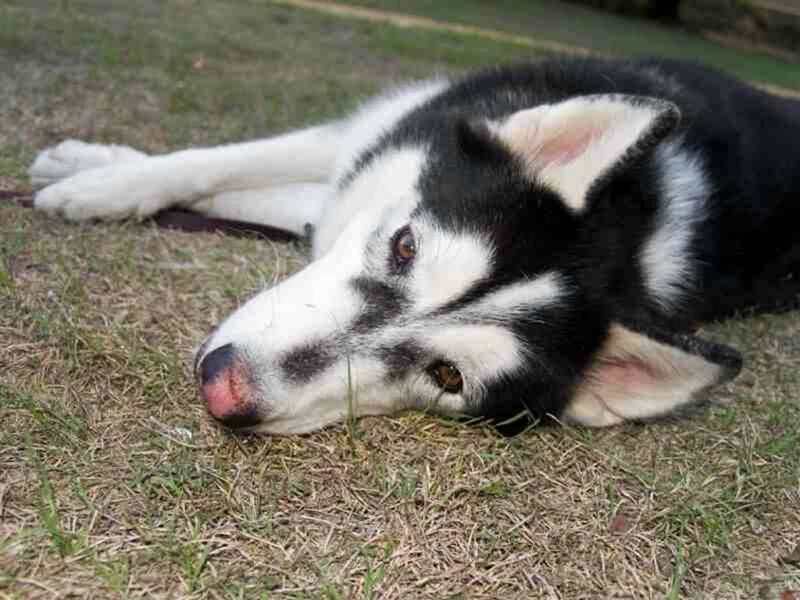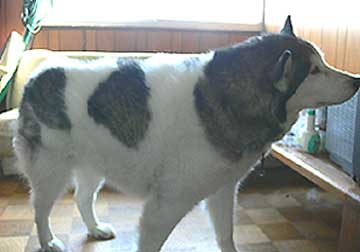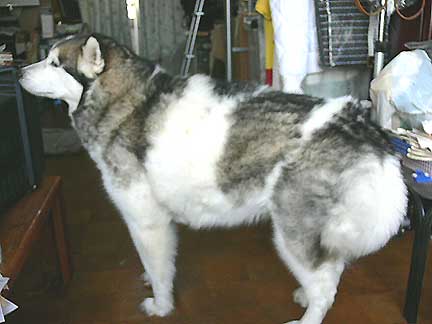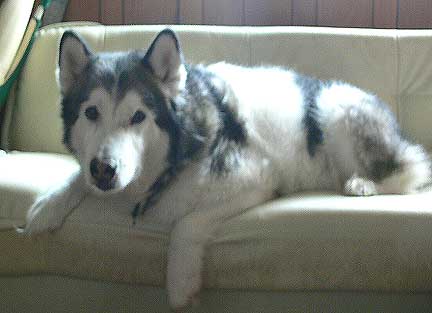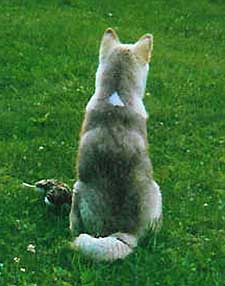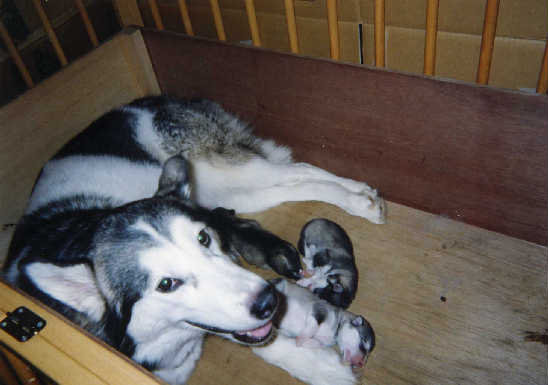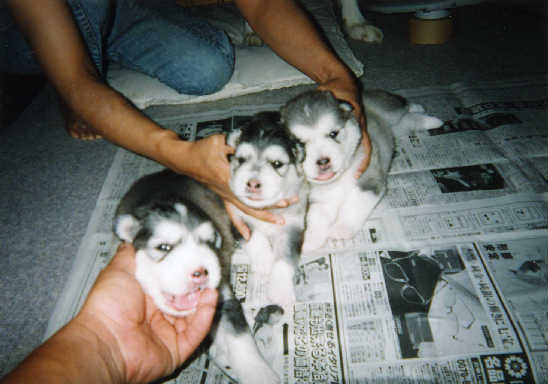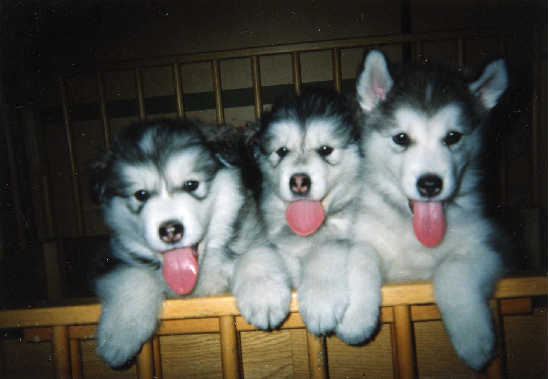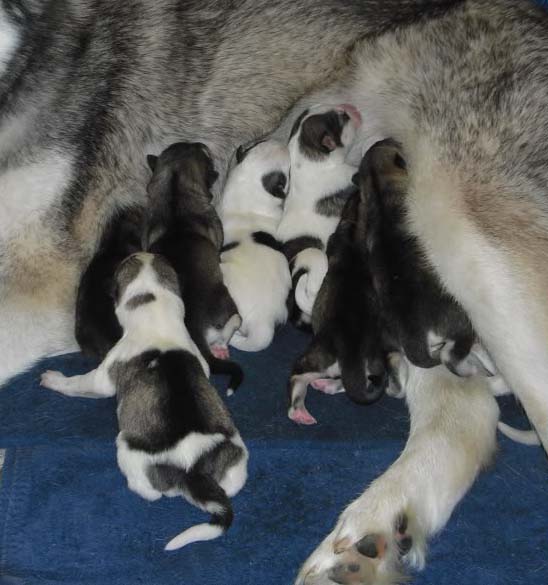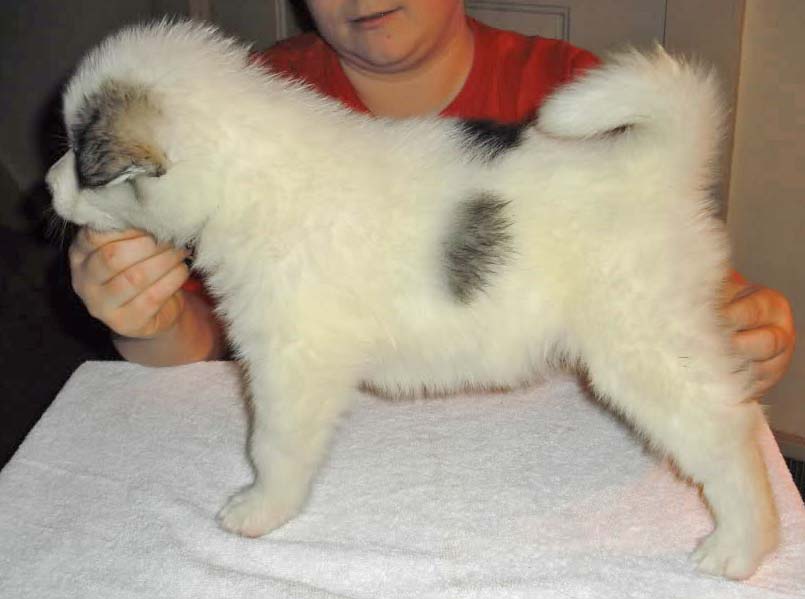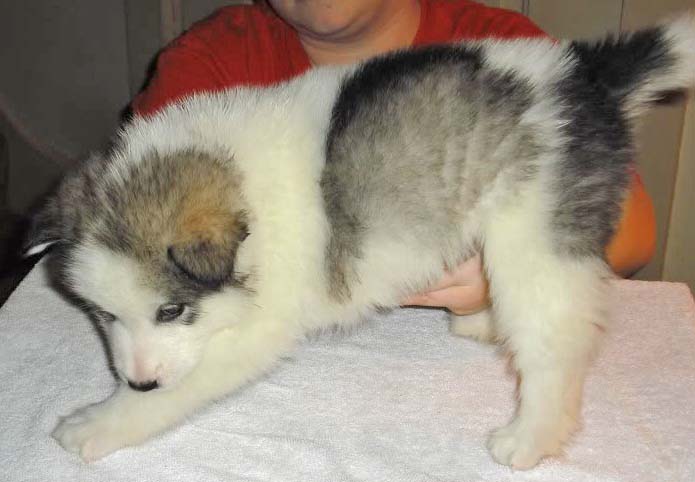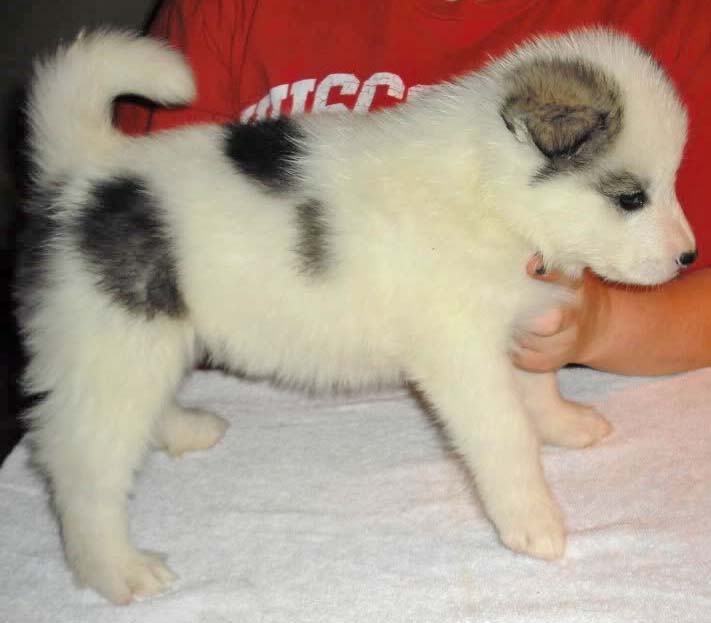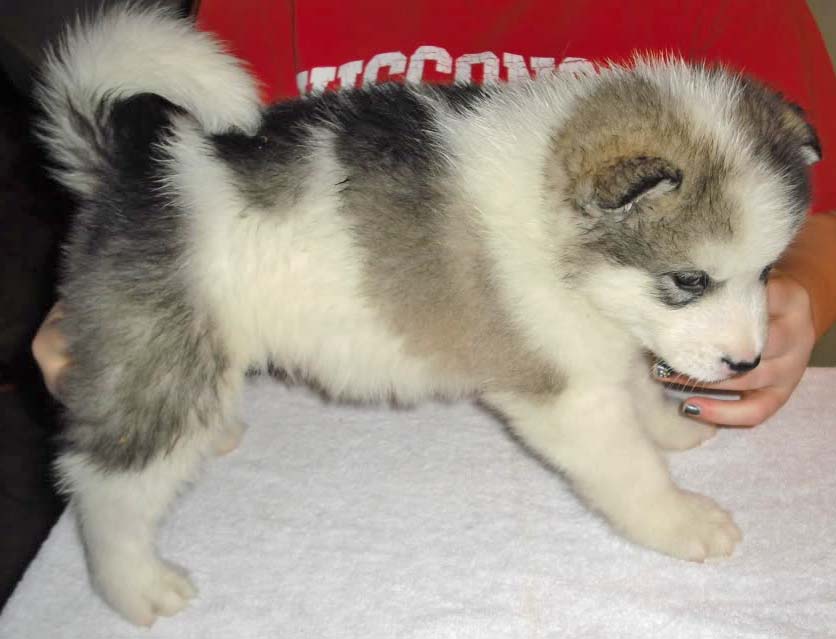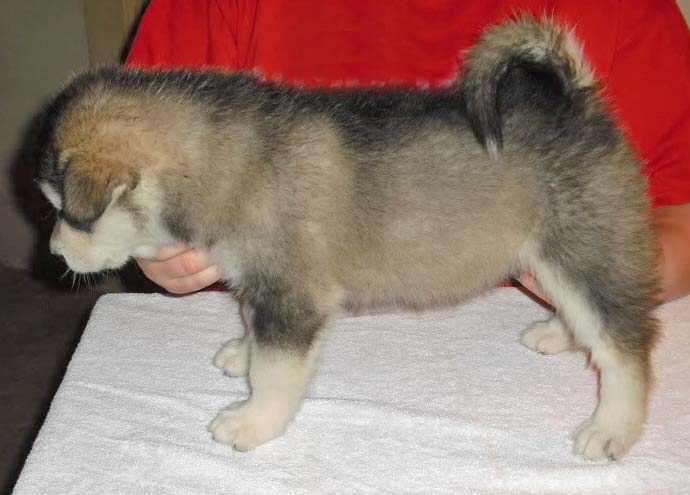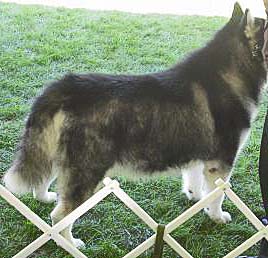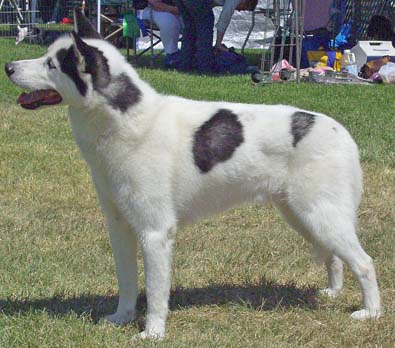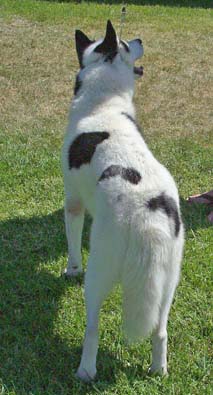White Spotting
Traditionally white markings in dogs have been attributed to the “S” locus, with 4 different alleles and a system of incomplete dominance explaining the range from solid colored dogs through partially white spotted dogs, to completely white dogs. This idea has never really lent itself well to what we actually see occur in Malamutes and in recent years the theory has not held up to scientific investigation. Studies are ongoing, and at this time the one thing that is clear is that we do not know the whole story.
I mentioned during my coat color presentation at the 2008 National that more information on this topic would be forthcoming. That casual comment has provoked more interest and more questions than I could have ever guessed. Because of the interest in this topic, I’m going to go ahead and update this site with what is currently known and what “I” suspect is happening with white spotting as it relates to Malamutes. This may not be the whole story and as yet is not wholly backed up by scientific evidence. It does, however, account for the actual breeding results observed. I expect we will see additional evidence and research on this topic in the next few years.
White Spotting on Malamutes
In addition to banding on the hair and color of pigment, white spotting is also present in Malamutes. There is often a lot of misunderstanding about what white spotting does and does not do. White spotting does NOT give us the white under-parts that are a trademark of Malamute color. That is instead caused by the Agouti and Domino loci giving us a pattern of darker hairs on the dorsal surface and lighter hairs on the ventral surface of the dog.
White spotting gives us white areas in addition to those typically seen lighter under-parts. These white areas can be difficult to find because they usually are in the same areas where Malamutes are already light colored/white (so we don’t see them) or are in areas joining those already white (so folks don’t realize they are being caused by something different).
It appears there may be two separate genes at work producing white spotting in Malamutes. This theory is consistent with what is being investigated in other breeds.
Irish (AKA “White Trim”)
This gene is not yet proven in scientific studies, and research is ongoing. There is no official name, however the gene is recessive and produces a mostly symmetrical pattern of white. I believe this is the primary cause of white spotting in Malamutes.
Unmarked
Malamutes homozygous for the dominant allele are unmarked (have no white markings). It is not unusual for these dogs to have colored hairs running down the backs of their hocks, color bands that are unbroken or almost unbroken on their chest, and no white tail tip. While they technically do not have white markings, it is not uncommon for these dogs to have very minor white spotting limited to their toes, chest, and tail tip. See the section on melanocyte migration at the end of this article for details on why this occurs.
Irish Markings (White Trim)
Malamutes who have larger amounts of white spotting most often have Irish markings (white trim). In its homozygous form this recessive gene produces white spotting on the legs, tail tip, chest, underbody, face, and neck. Usually more or less symmetrical, this gene produces white legs, belly, chest, tail tip, and can produce white around the muzzle and up the centerline of the face. Very narrow white markings up the centerline of the face are commonly seen in association with the Domino gene.
When I speak about markings being symmetrical I am doing so in a general sense – this gene does not typically produce markings where one front leg has white just on the toes and the other leg is completely white. On the other hand it is not uncommon for there to be small differences in the amount of white on the right and left side of the dog, often seen as white being higher up one front leg than the other, an uneven collar, or a split bar or white on the muzzle which is more prominent on one side than the other. These slight irregularities are often not visible or noticed unless they extend high up on the dog into the dark colored portion of their coat. What is not seen with Irish Markings is irregular, random patches of white.
In Malamutes we have come up with a variety of names for the different places and ways this form of markings can express itself. Blazes, stars, split bars, eagle markings on the chest, white collars, nape or wither spots, and white tail tips are all part of the spectrum we see in Irish Markings. This gene does not cause white spotting across the dog’s back between their neck and tail, does not cause streaks of white creeping up from the underbelly onto the sides of the dog, and does not normally produce white spotting from between the ears extending down onto the neck.
Like the Agouti locus, incomplete dominance is seen in Irish Markings. Dogs who are heterozygous have more white than homozygous “unmarked” dogs, but less than dogs Homozygous for white trim. This gives us a whole range of white markings produced by this gene from minimal white on the toes and chest to fully white legs, chest, collar, and white on the face (and everything in between).
In many breeds a white collar and blaze on the face is common when this gene is homozygous, and this may or may not be the case in Malamutes. This gene appears to be very sensitive to selection. Thus in our breed where there is ongoing selection for minimal white we may be seeing far less white expressed than is evident in other breeds of dogs with the same genetics. From a practical sense this means that, while most malamutes with white collars, nape spots, or white on their face are probably homozygous for this gene, not all dogs homozygous for this gene necessarily have white collars, nape spots, or blazes.
Random Spotting (S Locus - piebald)
As I said before, at this point the genetics for “White Trim” or true “Irish Markings” are theoretical and there is a lot still to be confirmed. What we do know is that the old theory of multiple alleles on the “S” locus does not seem to account for what we actually see produced in Malamutes. Piebald is only seen in extremely rare instances, and piebald pups usually come from parents who have minimal to no white markings.
Where the gene for White Trim has not yet been conclusively studied, the gene for Random Spotting (the “S” locus – what was previously thought of as “white spotting”) has been studied in a little more detail. The results were surprising. Contrary to long held traditional theory, this locus does not appear to have 4 separate alleles producing all the patterns of white spotting seen in dogs. Instead it only appears to have two alleles.
For details please visit
While the gene itself has been studied in detail, the effects of this particular gene have not been looked at in Malamutes. Breeding results suggest that the gene is not common in the breed. Thus what I am stating here is based on actual observations of a very small number of known litters containing piebald puppies. These observations may change if more information becomes available.
SS – Homozygous Solid
As with “Unmarked” dogs, Malamutes homozygous for the dominant “Solid” allele have no white markings. It is not unusual for these dogs to have colored hairs running down the backs of their hocks, color bands that are unbroken or almost unbroken on their chest, and no white tail tip. While they technically do not have white markings, it is not uncommon for these dogs to have very minor white spotting limited to their toes, chest, and tail tip. See the section on melanocyte migration at the end of this article for details on why this occurs.
Ss – Heterozygous for Random Spotting
The amount of white on dogs heterozygous for random spotting (meaning they inherit the solid gene from one parent and the random spotting gene from the other parent) seems to vary considerably. In some breeds those individuals who carry the gene have very little white – little more than white toes, white on the chest, and possibly white on the tail tip. In other breeds those dogs who carry Random Spotting have psudo-irish markings involving white on all four legs and often a wide collar around the neck.
Because the effects of this gene have not been studied in Malamutes, I can only base what I say here on the 4 Malamute litters containing a piebald puppy that I have actual knowledge of. In each of these litters both parents exhibited minimal to no white on their feet, chest, and tail tip. They had no white beyond what is common and considered entirely acceptable in the breed. They did not have white collars, uneven or particularly excessive amounts of white on their legs, or even noticeable white blazes. The one Piebald Malamute I know of who was used for breeding produced a litter of puppies in which not a single one had any excess white. Thus the very small pool of confirmed knowledge we have about this gene in Malamutes suggests that those dogs who carry the gene do not show more than minimal white markings.
That said, there is a great deal of research left to be done. It is quite possible that carrying the gene actually produces a range of white markings, but that most Malamutes with excessive white markings are not selected for breeding – thus the few litters produced are out of parents who just happen to have very limited white. More research and a larger pool of data is needed.
ss – Homozygous Random Spotting
Dogs who are homozygous for Random Spotting are Piebald. While not common in Malamutes, Piebald historically existed in the base population from which malamutes came and occurs in Inuit Sled Dogs, Siberian Huskies, and Samoyeds. It does turn up very infrequently in Malamutes.
Random Spotting (Piebald) is a recessive causing random white patches which most often cross the dorsal centerline of the dog (the back and neck). These patches occur in a random and unpredictable pattern, thus the appearance of these dogs will vary greatly. The net effect, however, gives the broken color or uneven splashing that is listed as undesirable in the standard. Thus this gene has been heavily selected against in the breed.
Additional comments on the gene for Random Spotting
As with the gene for White Trim, the gene for Random Spotting appears to be sensitive to selection. By retaining only those dogs for breeding who express this gene in its heterozygous form to the minimal extent, I believe there inadvertently may have been selection for minimally marked Piebald. Most piebald malamutes are less than 50% white, and it’s possible that there are piebalds produced who are not clearly piebald. In the documented Malamute litters containing Piebald pups the number of classic piebalds is smaller than would be expected for a simple recessive. Those litters, however, sometimes included pups with white markings that do not correlate with what is normally seen in Irish Markings. Most notable are those with white blazes beginning between the ears and widening out down the back of the dog’s neck, Irish-like markings but with a wide “shawl” covering their neck from ears to withers, pups with white patches running up from the belly into the color on the side of the dog, and pups with large amounts of white on their tails. It is possible that these pups could be homozygous for Random Spotting but expressing Piebald to a minimal extent. It is also possible that they represent heavily marked carriers of the gene, or perhaps that these are the effects of combining both types of white spotting together in one dog. Further study specific to the breed is needed to clarify this.
The importance of white spotting
My own personal feelings on white spotting are that “no good sled dog is a bad color”. That said, the genes for white spotting tend to be of great concern to many malamute breeders because uneven markings are seen as a negative characteristic in the show ring. The standard states “A white blaze on the forehead and/or collar or a spot on the nape is attractive and acceptable. The Malamute is mantled, and broken colors extending over the body or uneven splashing are undesirable.” This can be interpreted a number of ways, however from a coat color genetics perspective it suggests that the scope of white produced by Irish markings can generally be considered attractive even if (by their nature) they aren’t always 100% symmetrical.
The patches of white caused by Random Spotting may be viewed in a different light by many breeders. There is some basis for choosing to not select for this characteristic, primarily because selecting to the extreme for a lack of pigment on the head could potentially result in producing dogs who lack hearing in one or both ears. This is not a problem in the breed and is unlikely to ever become one.
There is now a genetic test available which can be used to identify the gene for random spotting in some breeds. The breeder of the piebald pups above was kind enough to allow me to have one of the pups tested. The results came back Ss - suggesting that either the pup only carried one gene for piebald (unlikely) or that the current test is not ideal for testing this gene in Malamutes. That does not mean that an accurate test may not be available in the future, and if so it can be utilized to limit the genes impact on a breeding program. Very similar to the long coat gene, a genetic test would allow breeders to utilize piebald dogs and/or carriers in their breeding program without ever producing a single Piebald puppy.
melanocyte migration
Melanocytes are the cells in the skin that produce melanin (pigment), and they are responsible for coat color in dogs. During the time an embryo is developing, melanocytes migrate from the spinal column out to the other parts of the body. The last areas melanocytes reach are the toes and chest. This migration occurs fairly late in the development of the fetus, and any delay in development can cause the process to be incomplete. Areas the melanocytes do not reach by the end of development will be white. This is why it is so common to see white toes or chest spot in just about every breed of dog.
It is possible that there is an inheritable factor in the rate at which Melanocytes migragrate. Beyond that, however, there does not appear to be a specific gene involved in this situation. Anything that might cause a slight delay in development (such as stress or illness in the dam) is likely to play a roll.
The search for more information
One of the problems with discussing the topic of Piebald in Malamutes is the lack of information and the very limited number of Piebald puppies born. I would very much like to discuss any litter containing a piebald or oddly marked puppy, and will be happy to keep the information confidential. All information will lead to further understanding of the genetics involved. I also would love to have additional pictures of Piebald Malamutes to use on this site.
